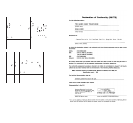
148
Glossary
To help you understand the main technical terms
and abbreviations used in this booklet and take full
advantage of the features on your mobile phone,
here are a few definitions.
Active Folder
Ability to answer a call simply by opening the phone.
Call Barring
Ability to restrict outgoing and incoming calls.
Call Diverting
Ability to reroute calls to another number.
Call Holding
Ability to put one call on standby while answering or
making another call; you can then switch between
the two calls, as required.
Call Waiting
Ability to inform users that they have an incoming
call when engaged on another call.
Caller Line Identification Services (Caller ID)
Services allowing subscribers to view or block the
telephone numbers of callers.
Glossary
149
GPRS (General Packet Radio Service)
New non-voice value-added service that allows
information to be sent and received across a mobile
telephone network. GPRS guarantees continuous
connection to the Internet for mobile phone and
computer users. It is based on the Global System
for Mobile Communication (GSM), circuit-switched
cellular phone connections and the Short Message
Service (SMS).
GSM (Global System for Mobile
Communication)
International standard for cellular communication,
guaranteeing compatibility between the various
network operators. GSM covers most European
countries and many other parts of the world.
Java
Programming language generating applications that
can run on all hardware platforms, whether small,
medium or large, without modification. It has been
promoted for and geared heavily to the Web, both
for public Web sites and Intranets. When a Java
program runs from a Web page, it is called a Java
applet. When it is run on a mobile phone or pager, it
is called a MIDlet.
Multiparty Calling
Ability to establish a conference call involving up to
five additional parties.
Phone Password
Security code used to unlock the phone when you
have selected the option to lock it automatically
each time it switches on.


















